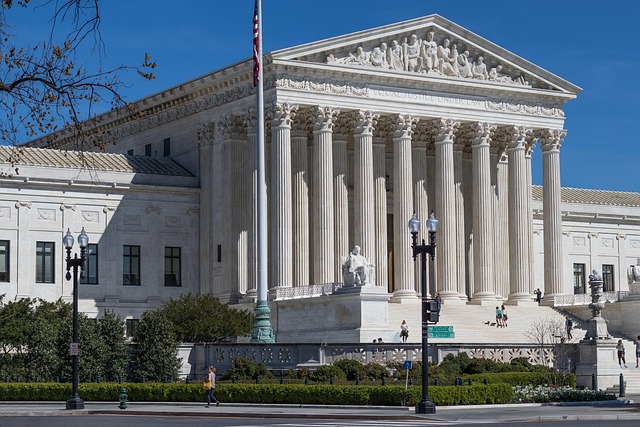
More Thoughts on NCN Litigation and Nationwide Injunctions
05.05.2025 | Linda J. Rosenthal, JD

Brilliant French philosopher Auguste Comte (1798-1857) is credited with naming and systematizing the discipline of sociology (“sociologie”) as well as founding the ideology and movement known as positivism (“positivisme”). A prolific writer, he had legions of “English admirers and French disciples.”
Alas, he was decidedly less successful maintaining steady employment, especially in academia. After he was “relieved of all his duties at the École Polytechnique” in 1842, his most devoted followers began a “voluntary subsidy” which they continued until his death in 1857.
But churning out masterworks like his upcoming four-volume Système de politique positive (1851–54) was costly and he needed supplemental funding.
So the great intellectual got creative.
He turned to … crowdfunding.
Of course, Auguste Comte would not have described his financial appeal as crowdfunding. He would not have recognized that English word at all; its first recorded use wasn’t until 2006.
What the famous philosopher launched on March 14, 1850, was a “public subscription.” Its purpose was crystal clear from documents including receipt forms: “la Souscription publique destinee a soutenir mon existence materielle.” The money poured in because he had a preexisting worldwide network of supportive friends, colleagues, and fans who corresponded regularly – with him and with each other. Not lightning-speed communications, but it worked.
The “phenomenon of crowdfunding is older than the term ‘crowdfunding.’” Auguste Comte’s appeal was not the first or last historical example before the age of the internet. For instance, in the early 1700s, author Jonathan Swift created the Irish Loan Fund to “provide loans to the poor”; in 1783, Wolfgang Amadeus Mozart solicited funds “to perform his concerto at a Viennese concert hall.”
A few decades after the Parisian philosopher’s bold and successful plea for support, there was another notable crowdfunding campaign. This one – also with a French connection – arose from that nation’s generous gift in the 1880s to America: the Statue of Liberty.
The fully paid-for monument arrived on our shores, but it was dismantled – in some 350 pieces – and without a base. The United States was on the hook for the $250,000 – millions in today’s dollars – to design and build a suitable pedestal. See How Joseph Pulitzer Saved the Statue of Liberty (April 16, 2019), Emily Petsko, Mental Floss.
The American Committee for the Statue of Liberty, tasked with raising the funds for the base, came up with just half the needed amount. Congress and New York refused to foot the bill for the remainder. Lady Liberty languished in a warehouse as cities including Philadelphia and San Francisco made (unwelcome) offers to provide the cash in exchange for the statue itself.
“This was before the advent of American philanthropy,” Ms. Petsko explains, which “began around the time that Andrew Carnegie published his 1889 ‘The Gospel of Wealth’—an article urging other Gilded Age millionaires to give away a portion of their wealth for the common good.”
The Committee – in between half hearted threats to just send the gift back to France – decided to give the fundraising campaign one more try. They knew if they were “going to get the money …, they would have to get it from average Americans.” So they made public appeals across the country for donations of “any amount, however large and however small.” In exchange for a subscription to the statue fund, donors were promised “an illustrated certificate.” This solicitation failed, largely because Americans in the heartland viewed it not as a “national matter” but as a “New York affair.” And the paltry donation perk didn’t help, either.
Enter New York publishing magnate Joseph Pulitzer, a rags-to-riches immigrant success story who was appalled that the Statue of Liberty was “in jeopardy.” He was a fierce believer in the “journalism of action”; namely, that “print media could be used to influence people for the betterment of society.”
(Putting aside for the moment that he was one of the two main combatants in the “yellow journalism” newspaper wars of that era), Pulitzer ran a masterful crowdfunding campaign to save what has become one of our nation’s most beloved monuments.
There were “small fundraisers, which included boxing matches, theater productions, art shows, and the sale of mini Statues of Liberty.” But the biggest weapon in his arsenal was his newspaper, The New York World. He wielded his editorial pen extravagantly to tug on the heartstrings of patriotic average Americans.
Most famously, he exhorted his readers to answer the call. “We must raise the money! The World is the people’s paper, and now it appeals to the people to come forward and raise the money.”
And then the powerful publisher took direct aim at the uber-rich who – apparently – couldn’t be bothered joining this noble cause: “The $250,000 that the making of the Statue cost was paid in by the masses of the French people,” Mr. Pulitzer explained, adding that the money came from “… the working men, the tradesmen, the shop girls, the artisans—by all, irrespective of class or condition.” He concluded with a flourish: “Let us respond in like manner. Let us not wait for the millionaires to give us this money. It is not a gift from the millionaires of France to the millionaires of America, but a gift of the whole people of France to the whole people of America.”
“Remarkably, it worked,” Emily Petsko tells us. Small donors – 125,000 of them – sent in an astonishing $102,000 (about $2.7 million currently) that secured the “monument’s future in New York.” Joseph Pulitzer was effective in the thank-you department as well; there were no little certificates this time. The newspaper kingpin printed the names of each contributor in The New York World, “whether they had contributed a dime or a dollar.”
That was then.
Without the internet, Joseph Pulitzer’s “… early experiment in … crowdfunding” nevertheless, “proved to be a pioneering example of what average Americans could accomplish without the backing of the rich.”
This is now.
Simply put, crowdfunding is the practice of funding a project or venture by raising small amounts of money from a large number of people. Appeals by private individuals and campaigns by nonprofit organizations have become more and more commonplace, the growth coinciding with the rapid development and expansion of the internet. Indeed, the 2020 pandemic – which caused many more people to use and rely on the web than previously – has spurred an exponential burst in online activity throughout American society including in the nonprofit sector.
We’ve known this – anecdotally – but the hard data has been sparse. Until now.
The paucity of data led the Indiana University Lilly School of Philanthropy to undertake a groundbreaking research study. Conducted in September 2020, the results have just been released: Charitable Crowdfunding: Who Gives, to What, and Why? (April 2021), Indiana University Lilly School of Philanthropy (full text of 24-page report).
The Lilly School published an introductory announcement and invitation to a free webinar on April 8, 2021. Listen in to the previously recorded webinar (about 1 hour). Distinguished participants include: Amy Sample Ward, CEO, NTEN; Lloyd Hitoshi Mayer, J.D., Associate Professor of Law, Notre Dame; and Una Osili, Ph.D., Associate Dean for Research and International Programs, Lilly School.
“Research released today … provides new insights into the use of crowdfunding for charitable giving, focusing on donors who give via crowdfunding and how they differ from traditional charitable donors.” But the report’s scope is much wider: It “looks at how crowdfunding fits into the larger philanthropic landscape and perceptions of crowdfunding by both crowdfunding donors and non-crowdfunding donors. It also provides a glimpse into Americans’ charitable behavior during the COVID-19 pandemic and their giving for social justice.”
Among the key takeaways is that donors who give through crowdfunding campaigns “are more diverse, younger, less religious and more likely to be single.” For this reason, and based on additional findings, “[c]rowdfunding has the potential to extend opportunities for generosity to a wider audience because of its digital presence, the apparent ease of using such platforms, and the ability to connect donors to both causes and individuals they wish to support.”
Dr. Una Osili adds: “As a philanthropic giving vehicle, crowdfunding is another tool in a donor’s toolkit, and the study shows that it complements rather than replaces their charitable giving. The growth of online giving signals a promising future for crowdfunding.” In short, the giving “pie” is much bigger than we thought. Nonprofits around the nation should grab a fork and start poking around for morsels of new donors. And, in some circumstances, these new social-media-savvy supporters may be willing to share the message and fundraising appeal.
One of the most intriguing findings in the Lilly School research is that new crowdfunding donors may initially be wary of doing more than giving their own money. The one exception they make, though, is for the ubiquitous Facebook birthday fundraisers. Apparently, the reluctance to ask friends, family, neighbors, colleagues, and old high school friends for contributions to worthy causes evaporates when wrapped in this warm and fuzzy package. The data confirms that these birthday appeals are raking in big bucks for charity.
Notre Dame law professor Lloyd Hitoshi Mayer is a leading expert on charitable crowdfunding, having written extensively on this developing topic. See Charitable Crowdfunding (September 22, 2020) Notre Dame Legal Studies Paper No. 200904, 70 pages and Abstract, updated February 3, 2021, online.
“Charitable crowdfunding is a global and rapidly growing new method for raising money to benefit charities and individuals in need. While mass fundraising has existed for more than a hundred years, crowdfunding is distinguishable from those earlier efforts because of its low cost, speed of implementation, and broad reach.” And, as “is often the case with new technology,” Professor Mayer explains, “both its benefits and its downsides are difficult to accurately measure and so tend to be identified through anecdotes instead of through comprehensive data.” This brings “confusion and unrealistic expectations” to “donors, organizations, and beneficiaries.”
The Lilly School research now fills the gap from anecdotes to hard data. This is welcome news, particularly to Lloyd Mayer, who has been urging caution for the past few years as policymakers and legislators have tried – unsuccessfully – to draft and enact workable regulation in this uncharted territory. “Existing laws relating to charitable solicitations and charities more generally have either uncertain or limited application to charitable crowdfunding.” And for government officials “who may be particularly sensitive to the potential downsides” of crowdfunding, the prior data gap as well as the insufficiency of existing law, has led only “to proposals that unnecessarily burden all campaigns to prevent what may be relatively modest and often curable harms caused by a few.”
Professor Mayer continues, as before, to advise lawmakers to avoid jumping into overregulation. It may unnecessarily squelch this new avenue of generosity, “given there is little evidence of widespread problems and any potential harm is almost certainly relatively small and easily remedied if it occurs.” For right now, he recommends just two legislative prongs: requiring notification to (a) designated beneficiaries “to help ensure funds raised reach” them; and (b) regulators, “but only for the small subset of campaigns that cross a relatively high threshold, to provide information about the scale and growth of charitable crowdfunding and help resolve any problems that arise with the largest campaigns.”
“During these unprecedented times, crowdfunding has taken on a significant role in philanthropic giving and fundraising.” Will it eventually overtake traditional fundraising? The experts are not sure; time will tell.
— Linda J. Rosenthal, J.D., FPLG Information & Research Director
